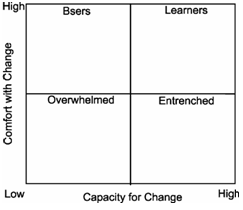Employee Response Patterns:
David Noer, a renowned expert on the psychological effects of downsizing, within his book Breaking Free, has introduced clear concepts for pinpointing ways of responding to change in today's work environment. Where he has proposed the Response Factor Model to define how individuals and organisations respond to change. The model suggests in that people differ in their reaction to change & transition and needed several strategies to move them towards the necessary learning response. They differ within their capacity to change (the ability to learn from their experience), and their comfort along with change (the readiness to learn). Below are four distinct response patterns and transition behaviours:
- Low comfort along with change and low capacity for change: Individuals within this response pattern are known as overwhelmed. Their basic transition behaviour is to withdraw from the fray and prevent new learning.
- Low comfort along with change and high capacity for change: Individuals along with this response are known as entrenched. Their basic transition behaviour includes tenaciously clinging to narrow learnings which worked in the past but are of limited value in the new reality.
- High comfort along with change and low capacity for change: Employees of this response category are known as BSers since they deceive themselves and others. That transition behaviour is aggressive & grounded in high drive and low substance.
- High comfort along with change and high capacity for change: Such employees are the learner type. The basic transition behaviour of the learner includes positively dealing with the change (engaging), and learning new and more relevant skills (growing).

Figure: Four Distinct Response Patterns and Transition Behaviours of Employees